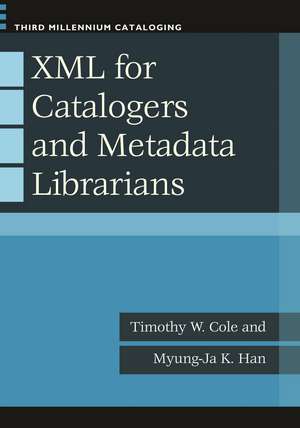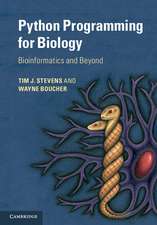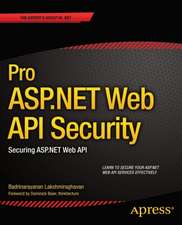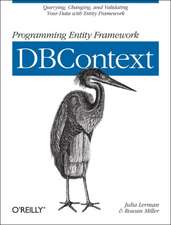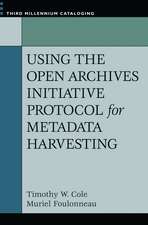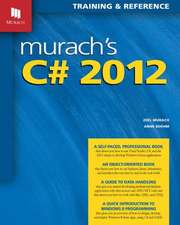XML for Catalogers and Metadata Librarians: Third Millennium Cataloging
Autor Timothy W. Cole, Myung-Ja K. Hanen Limba Engleză Paperback – 22 mai 2013 – vârsta până la 17 ani
Preț: 361.78 lei
Preț vechi: 484.65 lei
-25% Nou
Puncte Express: 543
Preț estimativ în valută:
69.25€ • 75.24$ • 58.21£
69.25€ • 75.24$ • 58.21£
Carte tipărită la comandă
Livrare economică 21 aprilie-05 mai
Preluare comenzi: 021 569.72.76
Specificații
ISBN-13: 9781598845198
ISBN-10: 1598845195
Pagini: 404
Ilustrații: 217 bw illus
Dimensiuni: 178 x 254 x 28 mm
Greutate: 0.8 kg
Editura: Bloomsbury Publishing
Colecția Libraries Unlimited
Seria Third Millennium Cataloging
Locul publicării:New York, United States
ISBN-10: 1598845195
Pagini: 404
Ilustrații: 217 bw illus
Dimensiuni: 178 x 254 x 28 mm
Greutate: 0.8 kg
Editura: Bloomsbury Publishing
Colecția Libraries Unlimited
Seria Third Millennium Cataloging
Locul publicării:New York, United States
Caracteristici
Includes case studies that draw from real-world applications that show how XML is used in library cataloging and metadata workflows
Notă biografică
Timothy W. Cole is mathematics and digital content access librarian; professor of library and information science; and professor, university library, at the University of Illinois at Urbana-Champaign.Myung-Ja K. Han is metadata librarian and assistant professor, university library at the University of Illinois at Urbana-Champaign. She has published papers on metadata quality and bibliographic control in various journals.
Cuprins
PrefacePART I INTRODUCTION AND OVERVIEWChapter 1 XML: What Is It?Many Definitions of XMLXML Elements As Content ObjectsThe Basic Markup Rules of XMLOHCO: Practical ConsiderationsHow the Rest of This Book Is OrganizedTools for Creating, Viewing, and Editing XML MetadataQuestions and Topics for DiscussionSuggestions for ExercisesNotesReferencesChapter 2 XML: Why It Is Important to Catalogers and Metadata LibrariansTrends in Bibliographic Control and Descriptive CatalogingChanging Job DescriptionsLooking AheadQuestions and Topics for DiscussionSuggestions for ExercisesNotesReferencesChapter 3 XML: Core Syntax and GrammarCharacter Data, White Space, and EntitiesElement TypesAttributesProcessing Instructions, Declarations, CDATA, and CommentsWell-Formed XML versus Valid XMLSchemas and NamespacesSummaryQuestions and Topics for DiscussionSuggestions for ExercisesNotesPART II STRUCTURED METADATA IN XMLChapter 4 MARCXML: Library Catalog Records as Structured DataTraditional MARCMARC SGMLMARCXMLCase Study 4.1: Creating an XML Snapshot of a Library Catalog for GoogleCase Study 4.2: Creating MARCXML Records for the HathiTrustSummaryQuestions and Topics for DiscussionSuggestions for ExercisesNotesReferencesChapter 5 Other Metadata Standards in XML: Dublin Core, MODS, and ONIXWorking with Other Metadata StandardsDublin Core in XMLCase Study 5.1: Dublin Core Metadata in CONTENTdmMODS in XMLCase Study 5.2: Hypatia: A MODS Record Creation and Ingest ToolONIX for Books in XMLCase Study 5.3: Integrating ONIX Records into the OPACOther Metadata StandardsQuestions and Topics for DiscussionSuggestions for ExercisesNotesReferencesChapter 6 Interoperable XML: Namespaces, Shareable Metadata, and Application ProfilesXML NamespacesShareable MetadataApplication ProfilesCase Study 6.1: Creating a Project-Based Application ProfileCase Study 6.2: IMLS DCC Collection Description Application ProfileObservationsQuestions and Topics for DiscussionSuggestions for ExercisesNotesReferencesPART III AUTHORING AND VALIDATING XMLChapter 7 Valid XML (Part I): Document Type DefinitionsWhen Well-Formed XML Is Not EnoughDefining an XML Metadata Grammar in a DTDSyntax and Semantics of DTDsCase Study 7.1: A DTD for Simple Dublin CoreQuestions and Topics for DiscussionSuggestions for ExercisesNotesReferencesChapter 8 Valid XML (Part II): XML SchemasThe Need for Alternatives to XML DTDsDifferences between DTDs and XSDsW3C XML Schema Definition Language IllustrationsCase Study 8.1: Checking MARCXML Records Using Oxygen and an XSDOther Schema LanguagesQuestions and Topics for DiscussionSuggestions for ExercisesNotesReferencesChapter 9 Advanced XML Grammars: Schemas and Namespaces, Uniqueness, and KeysUsing XML Namespaces and XML Schemas TogetherCase Study 9.1: A "Spine" of Metadata for Digitized Emblem BooksKeys, Key References, and Uniqueness ConstraintsCase Study 9.2: Creating the DLF Aquifer Asset Action XML SchemaQuestions and Topics for DiscussionSuggestions for ExercisesNotesReferencesPART IV METADATA CROSSWALKS, XML TRANSFORMATIONS, AND RDF XMLChapter 10 Transforming XML (Part I): Metadata Crosswalking and XPathMetadata CrosswalksUsing XPath to Analyze and Navigate XML Metadata RecordsXPath Operators and FunctionsSummaryQuestions and Topics for DiscussionSuggestions for ExercisesNotesReferencesChapter 11 Transforming XML (Part II): Extensible Stylesheet Language for TransformationsIntroduction to XSLTThe Structure of an XSLT Style SheetVariables and Parameters in XSLTRecursion and Advanced Uses of Axes in XSLTCase Study 11.1: Generating XHTML Splash Page from MARCXMLCase Study 11.2: Creating E-Book Records for Retrospectively Digitized BooksSummaryQuestions and Topics for DiscussionSuggestions for ExercisesNotesReferencesChapter 12 RDF and XML: Serializing Triples (Statements) in XMLAn Introduction to RDF in XMLRDF SchemaRDFaCase Study 12.1: RDFa from MARCXML and Dublin CoreQuestions and Topics for DiscussionSuggestions for ExercisesNotesReferencesChapter 13 XML and the Future of Descriptive CatalogingChanges and ChallengesExploiting XML in Library Work FlowsCase Study 13.1: Emblematica OnlineClosing ThoughtsQuestions and Topics for DiscussionSuggestions for ExercisesNotesReferencesGlossary of XML TermsIndex
Recenzii
A good foundation for implementing XML technologies. . . . The included case studies may very well inspire readers to investigate potential projects that expand library services. . . . The inclusion of exercises, topics for discussion, and working examples can be used in a classroom setting. Readers may also use the text for personal study to gain a working knowledge of XML technologies.
